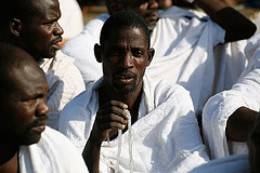… Continued
Allah The Exalted arranged the answer to this question in the form of "the symbols of Allah The Almighty". Allah The Almighty Says (what means): {Indeed, as-Safa and al-Marwah are among the symbols of Allah. So whoever makes Hajj to the House or performs ‘Umrah - there is no blame upon him for walking between them. And whoever volunteers good - then indeed, Allah is Appreciative and Knowing.} [Quran 2:158] Allah The Exalted made some things, for their historical importance, "symbols" i.e. signs of Him. Furthermore, Allah The Almighty provided around these symbols a specific atmosphere so that witnessing them is considered witnessing supreme facts in order for man to indirectly find the supreme facts that he cannot directly find in this world. Man can never find Allah The Almighty in the life of this world; however, he can watch the symbols of Allah The Almighty. Man can never find Allah The Almighty in the life of this world in terms of being in direct contact with Him or feeling close to Him; however, he can touch the symbols of Allah The Almighty, so he undergoes the sensory experience of divine closeness.
A symbol indicates a sign or a reminder. Hence, it is not an original thing in itself. Rather, it reminds us of the original by virtue of a certain relation. From among the examples of symbols are the two mountains of As-Safa and Al-Marwah, which were mentioned in the Quran in the verse (which means):{as-Safa and al-Marwah are among the symbols of Allah.}[Quran 2:158]
As-Safa and Al-Marwah are two mountains in Makkah near the House of Allah. The distance between them is about 500 feet. There were no inhabitants or water in this region when Ibraaheem, may Allah exalt his mention, settled his wife Haajar and his infant child Ismaa’eel, may Allah exalt his mention, there. When Haajar ran out of water, she ran seven times between these two mountains in search of water. Nowadays, pilgrims perform Sa’y (circuits) seven times between these two mountains to commemorate this incident.
Allah The Almighty loved this incident so He made As-Safa and Al-Marwah two of His symbols. That is to say that they are two original reminders of servitude to Allah The Almighty. We remember the entire history upon seeing As-Safa and Al-Marwah, when a slave of Allah left his fertile homeland of Iraq and settled his wife and son in a barren region seeking only the pleasure of Allah The Almighty. This is a perfect example of relying upon Allah The Almighty and trusting Him.
The same applies to the Ka‘bah, the Black Stone and the other sites of Hajj. All of them are symbols of Allah The Almighty. They are signs of the life of sincere servitude led by the perfect monotheist Ibraaheem, may Allah exalt his mention. We remember the monotheistic life of Ibraaheem, may Allah exalt his mention, upon seeing these symbols. The greatness and sublimity of Allah The Almighty is embodied to whoever looks at them. Whenever man is in the vicinity of these symbols, he feels as if he is in the proximity of Allah The Almighty Himself.
The impact of touching the Black Stone is awakening the spiritual emotions of the human soul to satisfy and reliving these overflowing emotions in the hearts. Thus, man longs to perform Tawaaf around it to satisfy this emotion by making Tawaaf around the Sacred House of Allah The Almighty.
Man wants to run in the cause of Allah The Almighty while obtaining relief for these emotions when he performs Sa’y between As-Safa and Al-Marwah. Therefore, all the rituals of Hajj satisfy, in one way or another, the emotions inherent in the human soul. They are his means for establishing a sensory relationship with his Lord in this world.
The emotion of servitude to Allah The Almighty alone is inherent in the nature of man. Polytheism and the act of worshipping idols are nothing but abuse of this intuitive emotion. In contrast, the creed of monotheism steers this natural emotion in the right direction. The same applies to the rituals of Hajj. Hajj, in one respect, corrects a human error. It prevents man from moving in the wrong direction and guides him to the right one. Hajj is the right form of satisfying a human emotion which man seeks to satisfy in a false manner.
The corrupt and deviant person wants to "see" his Lord in the life of this world and to "find" Him in a sensory manner to perform the rites of worship before Him. In order to assuage this emotion, man carved visible images, idols and statues and started worshipping them thinking that they represent Allah The Almighty. Nonetheless, this behavior constitutes "polytheism"; that is to say deviation, as the Quran calls it. The symbols of Allah The Almighty are a better and more correct answer for the human search that errantly relieves an intuitive emotion in the form of idols.
To be continued …
The Emotional Dimension of Hajj - I
The Emotional Dimension of Hajj - III


 Home
Home Discover Islam
Discover Islam Quran Recitations
Quran Recitations Lectures
Lectures
 Fatwa
Fatwa Articles
Articles Fiqh
Fiqh E-Books
E-Books Boys & Girls
Boys & Girls  Articles
Articles










